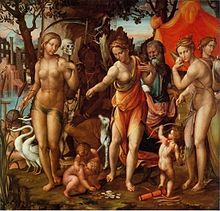
Back Parkalar AZ Парки Bulgarian Parques Catalan Parcae Danish Parzen German Parcas Spanish Parkad ET Parkak EU Parcae Finnish Parques French



In ancient Roman religion and myth, the Parcae (singular, Parca) were the female personifications of destiny who directed the lives (and deaths) of humans and gods. They are often called the Fates in English, and their Greek equivalent were the Moirai. They did not control a person's actions except when they are born, when they die, and how much they suffer.[1]
The Parcae recorded the metaphorical thread of life of every mortal and immortal from birth to death. Even the gods feared them, and by some sources Jupiter was also subject to their power.[2]
Nona was supposed to determine a person's lifespan on the dies lustricus, that is, the day on which the name of the child was chosen, which occurred on the ninth day from birth for a male and the eighth for a female.[3]
The recurrence of the nundinae was also considered a dies festus and as such nefas by some Roman scholars as Julius Caesar and Cornelius Labeo, because on it the flaminica dialis offered the sacrifice of a goat to Jupiter in the Regia.[4]
According to some treatments, the Parcae seem to be more powerful than many, or perhaps even all, of the gods: "The power of the Parcae was great and extensive. Some suppose that they were subjected to none of the gods but Jupiter; while others support that even Jupiter himself was obedient to their commands; and indeed we see the father of the gods, in Homer's Iliad, unwilling to see Patroclus perish, yet obliged, by the superior power of the Fates, to abandon him to his destiny."[2] Similarly: "We have the clearest evidence of the poet for it, that whatever happens to us is under the influence of the Parcae. Jupiter himself can not interfere to save his son Sarpedon."[5]
- ^ "Fate | Greek and Roman mythology | Britannica".
- ^ a b Lemprière, John (1827). A Classical Dictionary: Containing a Copious Account of All the Proper Names Mentioned in Ancient Authors; with the Value of Coins, Weights and Measures, Used Among the Greeks and Romans; and a Chronological Table. Collin & Company. p. 580.
- ^ S. Breemer and J. H. Waszinsk Mnemosyne 3 Ser. 13, 1947, pp. 254–270: on personal destiny as linked to the collation of the dies lustricus.
- ^ Macr. Sat. I 16, 30.
- ^ Wieland ( Longman, Hurst, Rees, Orme, and Brown ), Christoph Martin (1820). Lucian of Samosata. p. 723.
{{cite book}}: CS1 maint: multiple names: authors list (link)